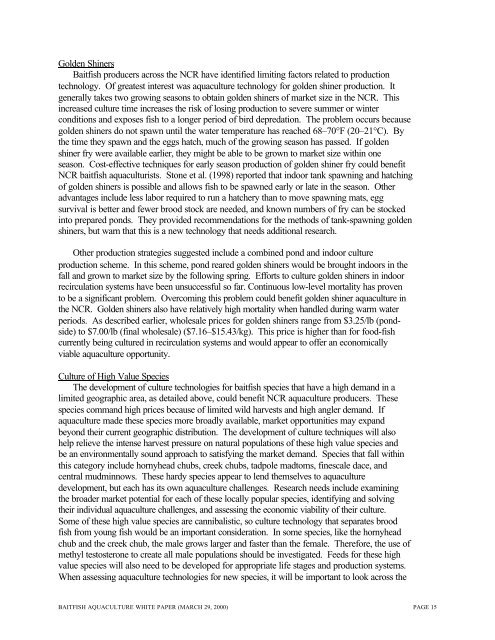a white paper on the status and needs of baitfish ... - NCRAC
a white paper on the status and needs of baitfish ... - NCRAC
a white paper on the status and needs of baitfish ... - NCRAC
You also want an ePaper? Increase the reach of your titles
YUMPU automatically turns print PDFs into web optimized ePapers that Google loves.
Golden Shiners<br />
Baitfish producers across <strong>the</strong> NCR have identified limiting factors related to producti<strong>on</strong><br />
technology. Of greatest interest was aquaculture technology for golden shiner producti<strong>on</strong>. It<br />
generally takes two growing seas<strong>on</strong>s to obtain golden shiners <strong>of</strong> market size in <strong>the</strong> NCR. This<br />
increased culture time increases <strong>the</strong> risk <strong>of</strong> losing producti<strong>on</strong> to severe summer or winter<br />
c<strong>on</strong>diti<strong>on</strong>s <strong>and</strong> exposes fish to a l<strong>on</strong>ger period <strong>of</strong> bird depredati<strong>on</strong>. The problem occurs because<br />
golden shiners do not spawn until <strong>the</strong> water temperature has reached 68–70°F (20–21°C). By<br />
<strong>the</strong> time <strong>the</strong>y spawn <strong>and</strong> <strong>the</strong> eggs hatch, much <strong>of</strong> <strong>the</strong> growing seas<strong>on</strong> has passed. If golden<br />
shiner fry were available earlier, <strong>the</strong>y might be able to be grown to market size within <strong>on</strong>e<br />
seas<strong>on</strong>. Cost-effective techniques for early seas<strong>on</strong> producti<strong>on</strong> <strong>of</strong> golden shiner fry could benefit<br />
NCR <strong>baitfish</strong> aquaculturists. St<strong>on</strong>e et al. (1998) reported that indoor tank spawning <strong>and</strong> hatching<br />
<strong>of</strong> golden shiners is possible <strong>and</strong> allows fish to be spawned early or late in <strong>the</strong> seas<strong>on</strong>. O<strong>the</strong>r<br />
advantages include less labor required to run a hatchery than to move spawning mats, egg<br />
survival is better <strong>and</strong> fewer brood stock are needed, <strong>and</strong> known numbers <strong>of</strong> fry can be stocked<br />
into prepared p<strong>on</strong>ds. They provided recommendati<strong>on</strong>s for <strong>the</strong> methods <strong>of</strong> tank-spawning golden<br />
shiners, but warn that this is a new technology that <strong>needs</strong> additi<strong>on</strong>al research.<br />
O<strong>the</strong>r producti<strong>on</strong> strategies suggested include a combined p<strong>on</strong>d <strong>and</strong> indoor culture<br />
producti<strong>on</strong> scheme. In this scheme, p<strong>on</strong>d reared golden shiners would be brought indoors in <strong>the</strong><br />
fall <strong>and</strong> grown to market size by <strong>the</strong> following spring. Efforts to culture golden shiners in indoor<br />
recirculati<strong>on</strong> systems have been unsuccessful so far. C<strong>on</strong>tinuous low-level mortality has proven<br />
to be a significant problem. Overcoming this problem could benefit golden shiner aquaculture in<br />
<strong>the</strong> NCR. Golden shiners also have relatively high mortality when h<strong>and</strong>led during warm water<br />
periods. As described earlier, wholesale prices for golden shiners range from $3.25/lb (p<strong>on</strong>dside)<br />
to $7.00/lb (final wholesale) ($7.16–$15.43/kg). This price is higher than for food-fish<br />
currently being cultured in recirculati<strong>on</strong> systems <strong>and</strong> would appear to <strong>of</strong>fer an ec<strong>on</strong>omically<br />
viable aquaculture opportunity.<br />
Culture <strong>of</strong> High Value Species<br />
The development <strong>of</strong> culture technologies for <strong>baitfish</strong> species that have a high dem<strong>and</strong> in a<br />
limited geographic area, as detailed above, could benefit NCR aquaculture producers. These<br />
species comm<strong>and</strong> high prices because <strong>of</strong> limited wild harvests <strong>and</strong> high angler dem<strong>and</strong>. If<br />
aquaculture made <strong>the</strong>se species more broadly available, market opportunities may exp<strong>and</strong><br />
bey<strong>on</strong>d <strong>the</strong>ir current geographic distributi<strong>on</strong>. The development <strong>of</strong> culture techniques will also<br />
help relieve <strong>the</strong> intense harvest pressure <strong>on</strong> natural populati<strong>on</strong>s <strong>of</strong> <strong>the</strong>se high value species <strong>and</strong><br />
be an envir<strong>on</strong>mentally sound approach to satisfying <strong>the</strong> market dem<strong>and</strong>. Species that fall within<br />
this category include hornyhead chubs, creek chubs, tadpole madtoms, finescale dace, <strong>and</strong><br />
central mudminnows. These hardy species appear to lend <strong>the</strong>mselves to aquaculture<br />
development, but each has its own aquaculture challenges. Research <strong>needs</strong> include examining<br />
<strong>the</strong> broader market potential for each <strong>of</strong> <strong>the</strong>se locally popular species, identifying <strong>and</strong> solving<br />
<strong>the</strong>ir individual aquaculture challenges, <strong>and</strong> assessing <strong>the</strong> ec<strong>on</strong>omic viability <strong>of</strong> <strong>the</strong>ir culture.<br />
Some <strong>of</strong> <strong>the</strong>se high value species are cannibalistic, so culture technology that separates brood<br />
fish from young fish would be an important c<strong>on</strong>siderati<strong>on</strong>. In some species, like <strong>the</strong> hornyhead<br />
chub <strong>and</strong> <strong>the</strong> creek chub, <strong>the</strong> male grows larger <strong>and</strong> faster than <strong>the</strong> female. Therefore, <strong>the</strong> use <strong>of</strong><br />
methyl testoster<strong>on</strong>e to create all male populati<strong>on</strong>s should be investigated. Feeds for <strong>the</strong>se high<br />
value species will also need to be developed for appropriate life stages <strong>and</strong> producti<strong>on</strong> systems.<br />
When assessing aquaculture technologies for new species, it will be important to look across <strong>the</strong><br />
BAITFISH AQUACULTURE WHITE PAPER (MARCH 29, 2000) PAGE 15


